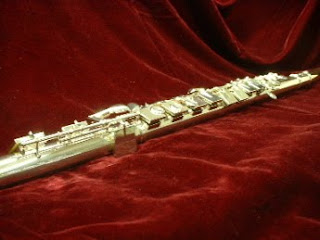Lopatin is no amateur, either as a flute maker or as a flautist. After receiving his degree at the Juilliard School of Music, he promptly became a member of the Metropolitan Opera Orchestra, playing piccolo and third flute. He might still be happily making music in New York City thirty years later had it not been for his temperament and his versatility. In addition to being a musician since childhood, Lenny had been a tinkerer. At age twelve, he had taken apart and put back together his first flute. As he told the British Flute Society’s journal, “It was only much later that I realized that this was not something all kids would think to do; it seemed normal to me.”
When he asked his teachers and instrument technicians why flutes were built the way they were, he was not satisfied with all the answers. By the time he was in high school, he was keeping a notebook with ideas related to flute design. In 1978, while touring with the Metropolitan Opera, he had the idea of square tone holes. The concept is appealing from the point of view of physical acoustics. With round holes, the vibrating column of air varies in length across the width of the hole. With square holes, the vibrating column of air has the same length at every location across the width of the hole. Ergo, a flute with square holes should resonate with a purer tone, require less effort by the flautist, and produce less extraneous noise.
 There are many flute makers in the world, most of whom create flutes as custom instruments made to order. Since no flautists were ordering flutes with square holes, there was little chance that flute makers would be interested in testing his ideas. Lopatin himself would have to learn how to make square holes and square caps. A flute maker must be a combination of skilled silversmith, precision machinist, acoustical engineer and musician. Becoming one is normally done through a five-year apprenticeship.
There are many flute makers in the world, most of whom create flutes as custom instruments made to order. Since no flautists were ordering flutes with square holes, there was little chance that flute makers would be interested in testing his ideas. Lopatin himself would have to learn how to make square holes and square caps. A flute maker must be a combination of skilled silversmith, precision machinist, acoustical engineer and musician. Becoming one is normally done through a five-year apprenticeship.After the 1978 Met season, Lopatin used the off-season to begin learning his new occupation. He worked in the newly opened shop of experienced flute maker Bickford Brannen and his brother Robert Brannen in Woburn, Massachusetts. Lopatin returned to New York for one more season at the Met, and then resigned to apprentice full-time at Brannen Brothers, a firm that is now renowned in the industry. Lopatin later struck out on his own as a flute maker, while performing occasionally with the Boston Pops and other groups. In 2002, he moved his machinery from the Boston area to Asheville, where the Lopatin Flute Company now occupies a studio at 122 Riverside Drive in the River Arts District.
Theobald Boehm was the flautist and inventor who changed almost everything between 1831 and 1847. The key system was radically altered. The bore became tapered rather than cylindrical. The walls were reduced in thickness and the hole placement was changed. Albert Cooper and Johan Brögger made minor adjustments in the twentieth century, but the instruments remained close to those of 1850. Lopatin’s instruments may represent the most radical change in the design of flutes since Boehm.
 Lopatin makes flutes both of the traditional design and in the SquareONE design using the usual silver or gold alloys. He constructs instruments primarily on commission. He recently began making piccolos using the traditional African blackwood (known as grenadilla). Still a musician as well as an instrument maker, he plays second flute with the Asheville Symphony Orchestra and has issued two CD’s featuring performances on his flutes. Squarely in the Holiday Spirit! is a collection of songs and carols performed on SquareONE flutes. Squarely Baroque is a compilation featuring Bach, Telemann and other baroque composers. More information is available at www.lopatinflutes.com or at (828) 350-7762.
Lopatin makes flutes both of the traditional design and in the SquareONE design using the usual silver or gold alloys. He constructs instruments primarily on commission. He recently began making piccolos using the traditional African blackwood (known as grenadilla). Still a musician as well as an instrument maker, he plays second flute with the Asheville Symphony Orchestra and has issued two CD’s featuring performances on his flutes. Squarely in the Holiday Spirit! is a collection of songs and carols performed on SquareONE flutes. Squarely Baroque is a compilation featuring Bach, Telemann and other baroque composers. More information is available at www.lopatinflutes.com or at (828) 350-7762.© 2009 Edward C. McIrvine
Arts Spectrum column #448
August 28, 2009




